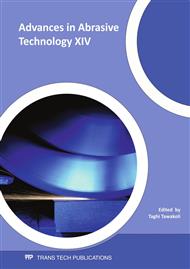p.476
p.482
p.489
p.495
p.502
p.508
p.517
p.523
p.530
Advanced Diamond Charging Process Using Vibrating Charging Ring in Fixed Abrasive Lapping
Abstract:
In the lapping of magnetic heads and other electronic components composed of multiple materials, differences in the processing characteristics of the composite materials produce residual steps on the surface at composite interfaces. Residual step heights have been reduced to as small as a few nanometers. We investigated using fine abrasives in fixed abrasive lapping to further reduce the residual step height. This requires highly secure, high-density embedding of abrasives on the lapping plate. To this end, we evaluated the surface morphology of the lapping plate after diamond abrasive charging and investigated the embedding mechanism of diamond abrasive charging. The results obtained will assist in determining the direction of future research and development. A prototype charging ring that uses a vibrating system was developed to increase the density of abrasives embedded on the lapping plate. This diamond charging using a vibrating system was able to increase the embedded abrasive density and improve the flatness of the charging plate.
Info:
Periodical:
Pages:
502-507
Citation:
Online since:
August 2011
Authors:
Keywords:
Price:
Сopyright:
© 2011 Trans Tech Publications Ltd. All Rights Reserved
Share:
Citation:


